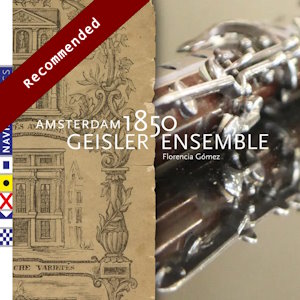
Amsterdam 1850
Johannes Meinardus Coenen (1824-1899)
Wind Quintet in A minor
Benoît Tranquille Berbiguer (1782-1835)
Duo Concertante, Op. 2 No. 1
Mathieu-André Reichert (1830-1880)
Rêverie for flute and piano
Geisler Ensemble
Florencia Gómez, Thomas Reyna (flutes)
Federico Forla (oboe), Elia Celegato (clarinet)
Federico Cuevas Ruiz (horn), Bernat Cili (bassoon)
Liene Madern-Stradina (fortepiano)
rec. 2023, Lutherse Kerk Haarlem, The Netherlands
Navis Classics NC24012 [58]
This is another one of those recordings in which I have to declare an interest, having interviewed Florencia Gómez for the booklet notes and knowing most of the people involved in the recording from their time at the Royal Conservatoire in The Hague. As ever, these people know where to find me, and if I didn’t like the results I wouldn’t write a review at all, so we’re already on safe ground.
The musicians of the Geisler Ensemble all play on original or copied instruments from the mid-19th century, and the name Geisler is particularly significant here, as the flute played by Florencia Gómez is an original made by Christian Gottfried Geisler, a name familiar to collections such as those in the Rijksmuseum Amsterdam and Edinburgh University. This is a 9-keyed instrument, in terms of development somewhere between the flutes apparently so disliked by Mozart and the full Theobald Böhm mechanism still in use in flutes today. Berbiguer’s Duo Concertante brings together two Geisler flutes in a very pleasant synergy which nevertheless points out the sensitivities of intonation with such early instruments. There are some fun virtuoso effects in the two movements in this piece, and Florencia Gómez and Thomas Reyna play this music with fearless rhythmic verve and impressive skill.
The final piece on this album is a lyrical salon piece by Mathieu-André Reichert, who counts as a Belgian flutist and composer but who ended up in Rio de Janeiro. The early flute balances nicely with the Dutch square piano recorded here and we sail away delightfully with this Rêverie as a finale, but it is of course Johannes Meinardus Coenen’s Wind Quintet that is the main work in this programme.
Coenen was a student of the Royal Conservatoire in The Hague, then known as the Royal Music School, and made his name as a conductor in Amsterdam. His own instrument was the bassoon so he knew his wind instruments, and this comes through in the four movements of the superbly scored Wind Quintet in A minor, which is a sunny and mostly jovial work despite its minor key designation. There are some fascinating passages as the natural horn squeezes its way through certain chromatic notes, but the instrumental timbre is full and rich, with a characterful buzz from the bassoon in the Scherzo. There is no problem in blending these sonorities however, and with these players’ sensitivities in dynamic shading the whole thing is both great fun to hear, and admirably capable of standing up to close scrutiny at every level, both musical and technical. This is virtuoso writing by any standard, “a clear example of the elevated level of musical material [Coenen] was able to deliver and perform.” Mechanical noise from instrumental keys is minimal, and where audible is all part of the distinctive character of this performance. The church acoustic used is resonant but by no means swampy, and the balance between presence and detail is ideal. The recording alchemy is in fact of demonstration quality in this piece, and through your best equipment you will find that there is a lovely amount of air in between the players with each well defined in the stereo soundstage, as well as creating a well-rounded ensemble sound.
This is an excellent programme of rarely heard music brought to life in a way that one can only imagine would have been the pride of musicians of the period. Coenen’s Wind Quintet appears not to have been published in its day, so this performance was based on the handwritten manuscript kept in The Nederlands Muziek Instituut, and as ever a good deal of research and many hours of effort has gone into the preparation of such a recording. As Florencia Gómez puts it, “Original instruments are extremely capricious and fragile, so finding each other in this chamber music is an experience of deep friendship, hard work, and joy in the results.” These qualities come through in every minute of this beautifully produced and eloquently annotated CD so, what more could you want?
Dominy Clements
Buying this recording via a link below generates revenue for MWI, which helps the site remain free

CD Availability: Bruno Klassiek

















